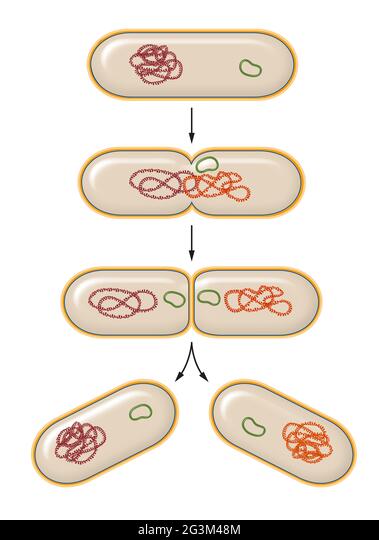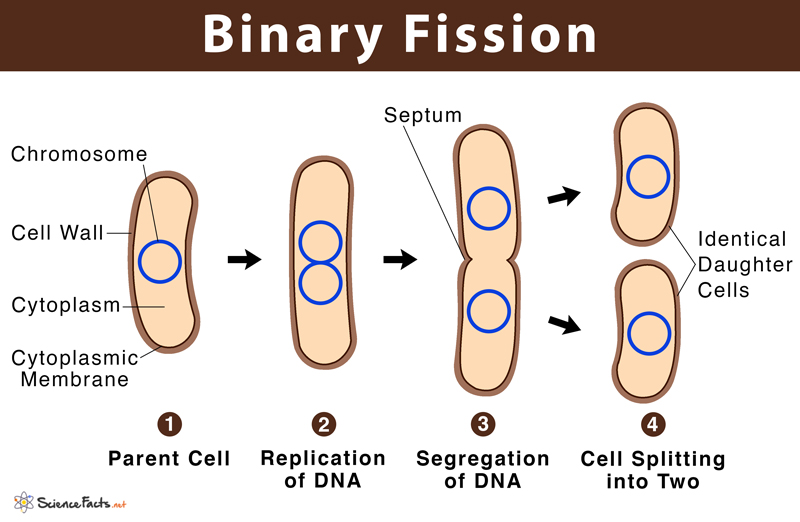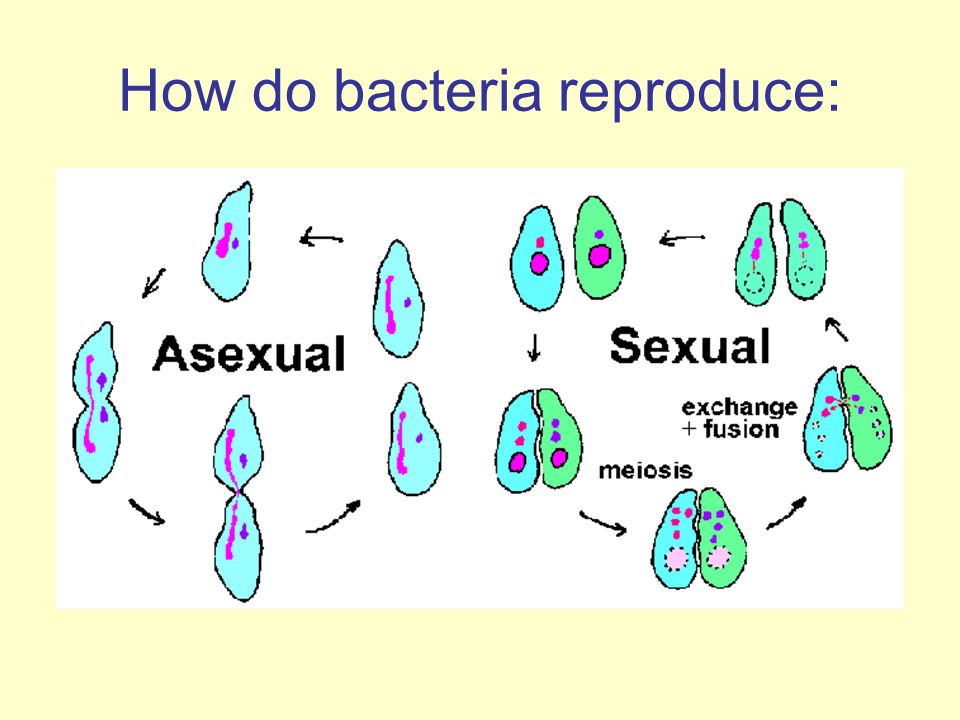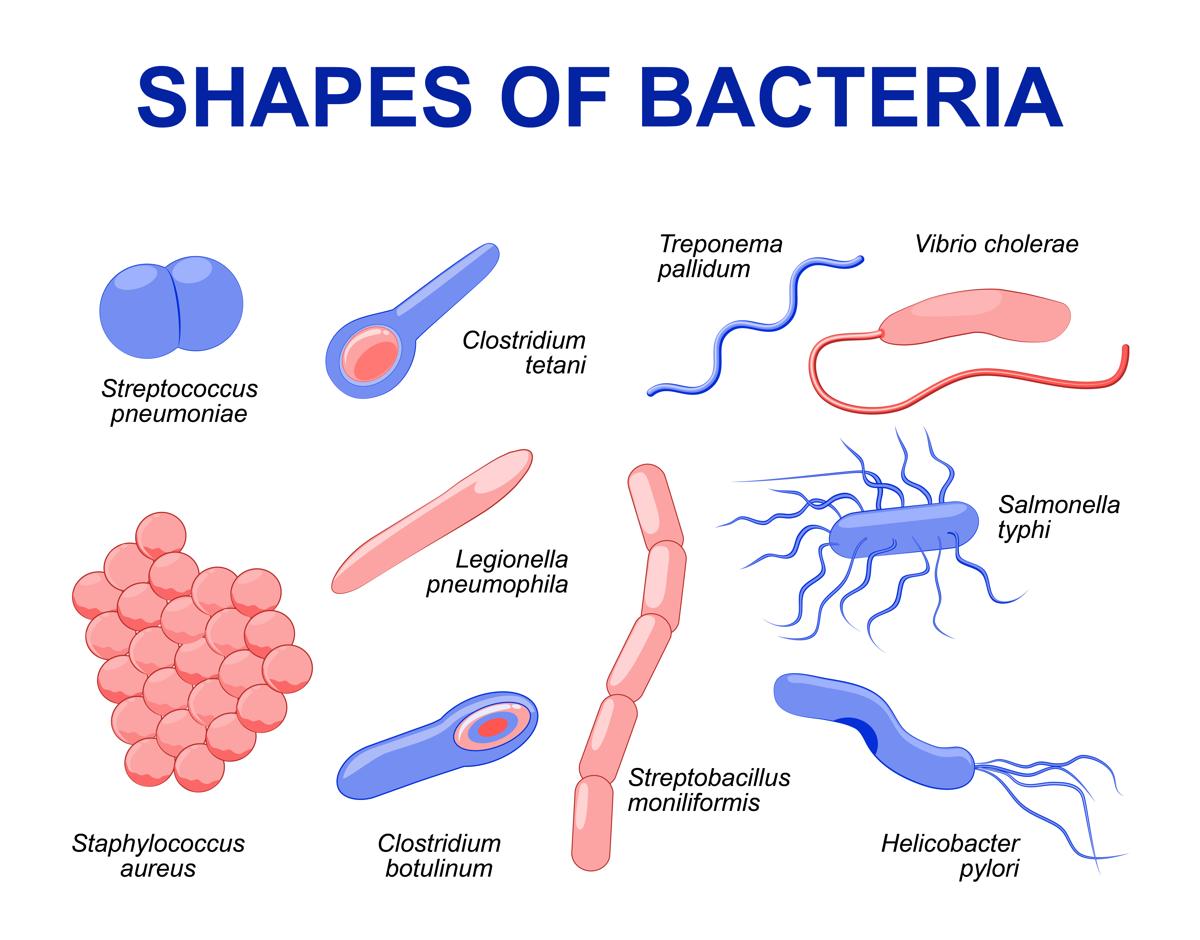When a single bacterium reproduces, the result is two identical cells. This process is known as binary fission. Binary fission occurs in most prokaryotes and is one of the most common ways that they reproduce.
Binary fission begins when a cell replicates its DNA and then undergoes mitosis to create two genetically identical cells. The new cells are smaller than the original cell and have no nucleus or other organelles. Once the new cells are formed, the old cell wall ruptures and the two newly formed bacteria swim away from each other.
A single bacterium reproduces by binary fission. It’s a simple process that takes only about 20 minutes from start to finish, but it results in two identical bacteria.
Binary fission occurs when the bacterium makes a copy of its genetic material and then divides into two cells. This process is known as DNA replication. The DNA is copied into new RNA molecules, which act as blueprints for protein synthesis. The new RNA molecules tell the cell when to divide and also instruct each daughter cell on how to make proteins needed for growth and survival.
The two resulting daughter cells are exact genetic copies of their parent cell, which means they carry identical sets of genes.
The process of binary fission is one way that bacteria grow. In fact, many types of bacteria must reproduce this way because they don’t have the ability to move around on their own or form spores like some other types of bacteria do
What results when a single bacterium reproduces?
A huge population of bacteria.
A single bacterium can reproduce by dividing into two identical daughter cells. This process is known as binary fission. As you might imagine, this results in a huge population of bacteria very quickly.
In fact, the doubling time for a bacterial colony is only 20 minutes. If we start with one bacterium and double every 20 minutes, we’ll have 2x2x2x2x2… x21=1,048,576 bacteria in just over 5 hours!
The answer to this question depends on what species of bacterium you are talking about.
For example, a bacterial cell with two chromosomes that reproduces will result in two daughter cells with two chromosomes each. This is the case for E. coli and other bacteria that have a single chromosome.
On the other hand, a bacterial cell with one chromosome will result in two daughter cells each with one chromosome. This is the case for B. subtilis, which has one chromosome consisting of DNA wrapped around specialized proteins called histones (see diagram).
In both cases above, the daughter cells are identical to their parent cell and will continue to live independently after division.
However, there are some exceptions to these rules. For example:
Some bacteria have more than one chromosome, such as Streptococcus pneumoniae which contains a single large circular chromosome and many smaller ones called plasmids (see diagram). When these bacteria reproduce by binary fission they produce two daughter cells that contain an identical number of chromosomes as their parent cell but they may vary slightly in size or shape depending on which plasmids they inherited from their mother cell during reproduction cycle
How does a Bacterium reproduce?

Bacteria are prokaryotes, which means they do not have a membrane-bound nucleus like eukaryotes. A bacterium reproduces by binary fission, where the DNA replicates and then splits into two identical halves. This process is often described as “one cell becomes two cells.”
Bacterial Reproduction
- The bacterium divides into two daughter cells that are genetically identical to one another and to their parent cell.
- As each daughter cell grows, it continues to divide until it reaches its maximum size, which varies depending on the type of bacteria.
- The size of a bacterium depends on its environment and the nutrients available for growth.
Bacteria are single-celled organisms that can reproduce asexually, by fission, or sexually. Bacteria reproduce asexually by binary fission, which means that one cell splits into two daughter cells.
In this process, the DNA of the parent cell is replicated and then divided into two identical copies. The cell membrane forms between the two daughter cells, and each new daughter cell has identical DNA to its parent.
Bacteria reproduce in a variety of ways. The most common method is called binary fission, in which the bacterium splits into two new bacteria.
Bacteria reproduce by dividing their DNA, forming two identical copies of themselves. The process is somewhat like cell division in higher organisms but is much simpler and faster because there are no chromosomes to replicate or other structures to deal with.
Binary fission occurs when a single cell divides into two cells that are genetically identical to each other and to the parent cell. This type of reproduction is common among prokaryotes (organisms whose cells lack a nucleus) and occurs by splitting one cell into two daughter cells that are identical clones of the original parent cell. This process usually takes less than 15 minutes for most bacteria and can occur many times during the life cycle of an individual bacterium.
Bacteria reproduce asexually through binary fission. During this process, the cell elongates and then splits into two identical daughter cells. The cycle is rapid, taking only about 20 minutes to complete.
In prokaryotes, the genetic information for reproduction is stored in a circular chromosome. This means that the DNA strands do not need to be copied before reproduction can occur. Instead, each parent cell makes an exact copy of its own DNA and passes that information along to its offspring cell as it divides.
The only time prokaryotes have sex is when they need to exchange genes with another organism so that they can adapt to their environment better and survive better as a species.
How do bacteria reproduce quizlet?
How do bacteria reproduce quizlet?
Bacteria reproduce asexually through binary fission. The process is similar to mitosis, but in this case the cell does not divide into two identical parts. Instead, one cell splits into two cells that are similar in size and shape to the original cell. This process happens quickly and can happen up to five times per hour.
The bacteria reproduce sexually through conjugation. In this method, there is an exchange of DNA between two cells. This allows for genetic diversity within the population of bacteria.
How do bacteria reproduce?
Bacteria reproduce by binary fission. After undergoing genetic changes, the daughter cells are identical to the parent cell.
How do bacteria reproduce?
Bacteria reproduce by binary fission. After undergoing genetic changes, the daughter cells are identical to the parent cell.
How do bacteria reproduce?
Bacteria reproduce by binary fission, which means that they split in half and each new cell gets a copy of the parent cell’s DNA.
How do bacteria reproduce?
Bacteria reproduce by binary fission, which means that they split in half and each new cell gets a copy of the parent cell’s DNA.
What is binary fission?
Binary fission is when a single bacterium divides into two daughter cells. Each daughter cell contains its own DNA and is capable of dividing again before it dies.
Bacteria reproduce when they divide into two or more cells. This process is called binary fission.
Bacteria can reproduce in three ways:
Binary fission – One parent cell divides into two new daughter cells. This is the most common mode of reproduction among bacteria.
Conjugation – Two bacteria of the same species connect, transfer DNA, and separate.
Spores – A small number of bacteria form a tough outer coating while they wait for conditions to improve before they will grow again.
Bacteria reproduce by binary fission, a process of cellular division that produces two genetically identical daughter cells. Binary fission is a form of asexual reproduction, and it is the primary method of reproduction for prokaryotes. The process begins when DNA in the cell’s nucleus divides into two identical copies, which migrate to opposite ends of the cell. The cell then uses its peptidoglycan layer as a scaffold, which forms a temporary septum between the two halves of the cell. The septum then breaks down, allowing each half of the original cell to become two new cells.
When bacteria reproduce, they do so asexually and by binary fission. Asexual reproduction is when the parent cell divides into two new cells. Binary fission is when a single parent cell divides into two new cells.
Binary Fission
Binary fission is the most common form of bacterial reproduction. It occurs in all prokaryotic organisms, including bacteria and archaea. During binary fission, the parent cell grows in size and then splits into two equal daughter cells that each have a copy of the original parent’s DNA. The process can be seen in this video: https://www.youtube.com/watch?v=YG9Mv5tyxZo
There are two basic methods that bacteria use to reproduce.
- Binary fission: This is the most common method of reproduction in bacteria. It occurs when the cell’s DNA splits in half, resulting in two identical daughter cells. The process begins with a complete replication of the chromosome and ends when each daughter cell receives a copy of the original DNA strand.
- Conjugation: Some species of bacteria use conjugation to reproduce instead of binary fission. This mechanism involves an exchange of genetic material between two different bacterial species, which can lead to the creation of new strains or species within the same genus or family.
Bacteria reproduce by dividing into two, or asexually. This is called binary fission. When food is plentiful, bacteria divide every 20 minutes, but when food is scarce, they slow down their division process.
Bacteria have no sex organs and no males or females. They reproduce by binary fission, which means that they split in half and each half becomes a new cell. This happens over and over again until the colony gets so big that each bacterium can only produce one more daughter cell before it dies.
The fastest-growing bacterium will fill up its environment with other bacteria before it gets too crowded to grow any more. The slower-growing bacteria will eventually die out because there are fewer nutrients available for them to survive on than for their faster-growing brothers and sisters (and because there are fewer of them to compete for those limited resources).
How do bacteria divide by binary fission?

Bacteria divide by binary fission. This means that the parent cell divides into two daughter cells, each with a full set of chromosomes.
Bacteria have a single circular chromosome that contains all their DNA. When the time comes for a cell to divide, each chromosome splits into two identical pieces. The cell then divides into two new cells, each with one copy of each chromosome.
Bacteria can also reproduce through sexual reproduction, but this happens rarely and only under certain conditions.
Bacteria divide by binary fission. This process is called cell division. In bacteria, the parent cell divides into two daughter cells that are genetically identical to one another and to the parent cell.
The process of cell division in bacteria is different from that in eukaryotes (cells with nuclei). Eukaryotic cells divide by mitosis, a process that involves duplicating all the contents of the cell and then dividing those contents into two new cells.
Binary Fission: The Basics
Binary fission is a simple process in which a single cell divides into two identical daughter cells. Binary fission takes place in all types of single-celled prokaryotes, including bacteria, archaea and protists such as amoebas.
In order for binary fission to occur, each daughter cell must have enough raw materials stored inside it to grow into a mature adult cell. This includes DNA (genetic material) and ribosomes (protein-building machinery). It also includes enzymes that can break down food molecules so they can be used as building blocks for new proteins and other molecules needed for growth.
Bacteria are prokaryotes, which means they do not have a nucleus and their genetic material is not packaged in chromatin. They reproduce by binary fission, which is a form of cell division in which the parent cell divides into two identical daughter cells.
Binary fission is a type of asexual reproduction that occurs when the DNA replicates to form two identical strands of DNA. The cell then divides into two parts that contain an equal amount of DNA. This process can be repeated indefinitely; however, this is not always beneficial for bacteria because they can become too crowded in the environment. Thus, many bacteria use binary fission as a method of reproduction until they reach a certain population size before undergoing other forms of reproduction such as conjugation or transduction.
Binary fission occurs when the bacterial cell has reached its maximum capacity for growth and divides into two identical daughter cells through chromosome replication and cell division. It was first observed by botanist Robert Brown under his microscope while studying starch grains from plants — he noticed that individual granules were splitting apart into smaller granules (like bacterial cells). He named this process “binary fission” in honor of dividing cells’ ability to replicate themselves into two
Bacteria are single-celled organisms in the kingdom Monera. They are microscopic and include many species, ranging from beneficial to harmful. Bacteria divide asexually by binary fission, which means they grow by splitting in half. There are no specialized forms or stages of growth in bacteria.
The process starts when the cell reaches its maximum size and divides into two daughter cells. The cell wall then grows around each daughter cell, which causes it to split into two separate cells. The entire process takes only a few minutes, with each daughter cell having identical DNA and genetic information as the original parent cell
How do most bacteria reproduce quizlet?
How do most bacteria reproduce quizlet
Bacteria reproduce asexually, by dividing in two. There are two ways that they can do this.
Bacteria can also reproduce sexually by conjugation. In this process, two cells come together and exchange genetic material. This is a very rare process for bacteria.
How do most bacteria reproduce quizlet?
Bacteria reproduce by binary fission. This is where one cell splits into two daughter cells. This process is similar to mitosis in eukaryotes, but there are some important differences. For example, in mitosis, each daughter cell receives a copy of the DNA genome from its parent cell, while in binary fission, there is no exchange of genetic material between the parent and daughter cells.
The process of binary fission can be broken down into three stages: G1 phase (gap 1), S phase (synthesis), and G2 phase (gap 2).
Most bacteria reproduce asexually (by binary fission).
Bacteria reproduce by binary fission. This involves the cell dividing into two equal parts, each containing one copy of the chromosome. The cell wall weakens and then splits in two, allowing the cell to separate. The daughter cells will have exactly the same DNA as their parents did, with no genetic variation between them and no need for meiosis or mitosis.
Some bacteria also undergo sexual reproduction, but this is uncommon in most species.
The cell cycle is the process by which a cell grows and divides. The cell cycle contains four distinct phases: G1, S, G2 and M.
The G1 phase is when the cell grows and prepares to divide. The S phase is when DNA replication occurs to create two identical sets of chromosomes. During this stage, the DNA also undergoes repair if damaged. The G2 phase is when the cell grows even more before dividing into two daughter cells. In multicellular organisms, mitosis occurs in M phase during this time period (in unicellular organisms like bacteria, mitosis occurs during S phase).
What are the 3 ways bacteria reproduce?

Bacteria reproduce in three ways:
Bacterial cell division is asexual reproduction. Bacteria divide by binary fission, meaning that one cell divides into two identical daughter cells. In other words, they reproduce by mitosis.
Bacteria may also reproduce sexually. Most bacteria are asexual; they don’t have male and female sexes like humans do. However, some species of bacteria can mate with each other to exchange genetic material and create offspring. This process is called conjugation and occurs only between closely related species of bacteria.
Some types of bacteria can also undergo cloning (parthenogenesis), which means they can produce offspring without any genetic material from another organism. Cloning is often used by scientists to create genetically identical organisms for research purposes or to develop new vaccines against bacterial diseases such as anthrax or cholera
Bacteria reproduce in a variety of ways.
Bacteria are unicellular organisms that reproduce asexually. This means that they do not need a mate to produce offspring. Most bacteria reproduce by binary fission, which involves splitting their DNA into two identical halves and then dividing into two new cells.
Some bacteria reproduce by budding, which is similar to binary fission in that the bacterial cell divides. However, instead of dividing into two new cells, the daughter cell remains attached to the mother cell’s outer membrane and grows larger until it eventually detaches as an individual cell.
Some bacteria also have sexual reproduction cycles. This occurs when two different types of bacteria combine their DNA together through conjugation or transformation (see below).
Bacteria reproduce by binary fission, or by budding. The process of binary fission is when a cell divides into two identical cells. Budding is when one cell splits off from another and becomes an entirely new bacterium.
Bacterial reproduction also occurs through conjugation. Conjugation is when two bacteria swap genetic material through a pili (fimbria) tube. This process can be used for genetic diversity in the bacterial population, but it can also allow for antibiotic resistance to be transferred between bacteria strains.
Bacteria reproduce in three basic ways:
- Binary fission
Bacteria divide in two, a process called binary fission. This is the most common form of reproduction for bacteria. The parent cell divides into two new cells, each with the same DNA as the parent cell. The new cells are exact clones of each other, so they are genetically identical to one another and to their parent cell.
- Conjugation (asexual)
In this process, bacteria exchange genetic material through a tube called a pilus or pili. A bacterium that has acquired genetic material from another bacterium can then use this information to grow better or resist antibiotics. Conjugation is asexual because it does not involve meiosis or fertilization by a male gamete (sperm).
How do bacteria reproduce asexual?
Asexual reproduction is the reproduction of a single organism. In asexual reproduction, the offspring are genetically identical to their parents. It is one of two types of reproduction that occur in single-celled organisms, such as bacteria. The other type of reproduction, sexual reproduction, involves the fusion of two cells (gametes) to create a new organism.
Bacteria reproduce by undergoing binary fission (budding). This means they divide their genetic material into two identical parts and then separate into two new cells. Each cell has exactly half of the original bacterium’s DNA.
To understand how bacteria reproduce asexually, it helps to know something about their structure. Bacteria are single-celled organisms that have no nucleus or other membrane-bound organelles like mitochondria or chloroplasts. Some bacteria even lack organelles altogether! They are prokaryotic, meaning that they do not have a nucleus or any other membrane-bound organelles within their cells.
Bacteria reproduce through binary fission, which means that they split into two new cells during cell division. Binary fission occurs when there is no longer room for additional growth in the cell; this happens when nutrients run out or if there is too much waste material inside the
There are two main ways that bacteria reproduce asexually: binary fission and fragmentation.
Binary fission is the simplest form of asexual reproduction, where one parent cell splits into two daughter cells, each with identical DNA to the parent cell. This process can happen whenever the cell needs to divide for any reason — for example, if the number of cells in a colony gets too large, or if there’s not enough nutrients available to support all of them.
Fragmentation is another form of asexual reproduction. Unlike binary fission, it doesn’t occur when cells divide normally, but instead requires an injury or stress to the bacterium’s outer membrane for it to occur. In this case, one part of the cell detaches from the rest and becomes an independent bacterium — like tearing off a piece of paper from a pad.
Bacteria reproduce by binary fission, meaning that the cell splits into identical offspring. Each daughter cell receives a complete copy of the parent’s DNA.
Asexual reproduction does not require sex organs such as testes and ovaries. Instead, it uses specialized structures known as spores. Spores can be produced by both plants and animals, but they are more commonly associated with fungi. The most familiar examples of spore-producing organisms are mushrooms and yeast.
Bacteria reproduce by binary fission, which is a form of asexual reproduction. It occurs in single-celled organisms like bacteria that lack specialized sexual organs. Binary fission occurs when one single-celled organism divides into two new organisms that are identical copies of their parent cell. This process is called binary fission because only two new cells are formed during reproduction (the prefix bi- means “two”).
Bacteria reproduce quickly and efficiently by binary fission because it does not require any energy or nutrients from outside sources.
The most common form of asexual reproduction in bacteria is binary fission. In this process, the bacterial cell simply splits in two, forming two new daughter cells.
The bacterium Escherichia coli (E. coli) undergoes binary fission approximately every 20 minutes. This process begins when two proteins called FtsZ and MreB polymerize into a ring at the center of the cell. The ring contracts, pulling the cell membrane into two halves to form a cleavage furrow. These separated membranes then pinch off and fuse with one another, creating two new cells that are identical to the original mother cell.
